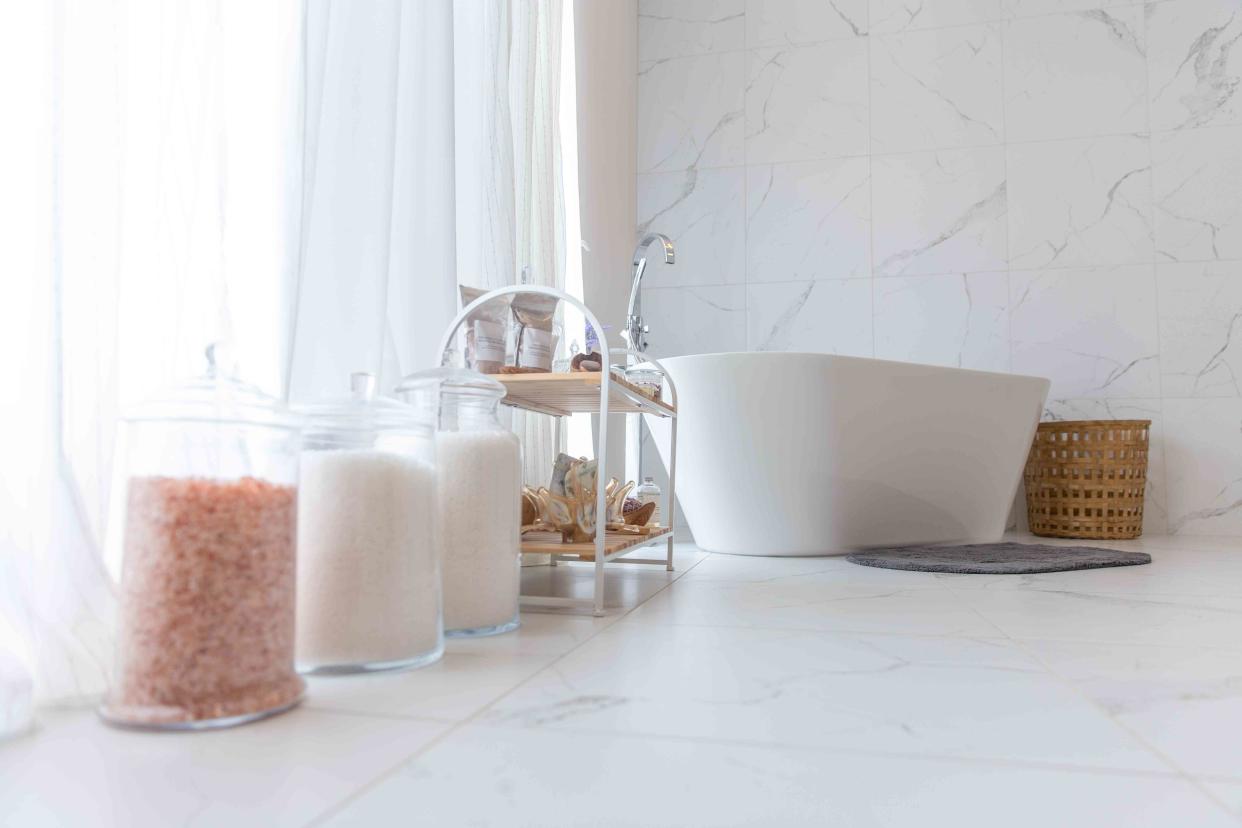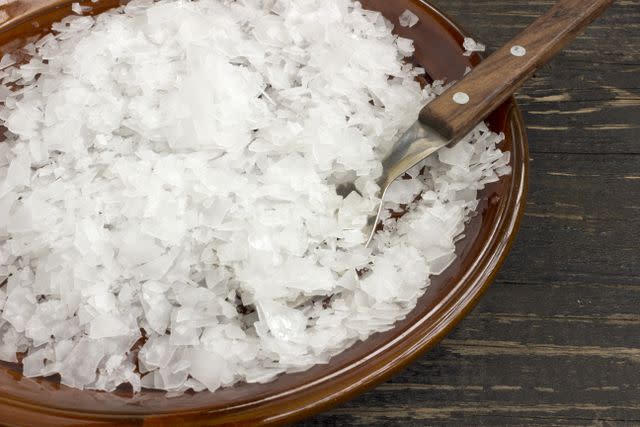A Guide to Epsom Salt Bath Benefits and Best Practices

Veronique Duplain/Getty Images
A long, relaxing steep in a warm bath works like magic for relieving daily stress and tight muscles. Mixing in bubbles, oils, and salts to customize your self-care soak elevates the experience and can provide additional benefits for your skin, muscles, and mental wellbeing.
Of all the options, Epsom salts are one of the most well-known and historically used bath additives out there. Initially discovered in Epsom, England, where natural mineral springs contain high levels of the salt, they’ve been used for spas and medicinal purposes since the 1600s. Over the following centuries, they’ve been extracted and sold to be tossed into tubs and touted as a skin-healing cure-all. More recently, Epsom salts have gained popularity on social media for a host of purported health effects—though some are treading into far-fetched or even risky territory.
Keep reading for our comprehensive guide to Epsom salt, from its potential benefits to the best ways to incorporate it into your wellness routine.
Meet the Experts
Dr. Heather Smith is a physician and founder of BareLuxe Skincare.
Limor Weinberg is a nurse practitioner, esthetician, and founder of The Clinic.
Heather Sandison is a naturopathic doctor in Encinitas, California.
What Is Epsom Salt?
Epsom salt is a natural mineral named after the town of Epsom, near London, England. The chemical structure is MgSO4, called magnesium sulfate. “When dissolved in water, the free magnesium and sulfate ions produce a highly mineralized solution; both magnesium and sulfate mineral baths are associated with health benefits, but most of the health effects come from the magnesium component,” explains Smith.
Health Benefits of Epsom Salt
While Epsom salt is most well-known as a bath treatment, there are a few additional uses. Since it contains a form of magnesium, some of the effects are due to the possible absorption of the mineral through the skin and into the cells and bloodstream. Magnesium is essential for regulating muscular contractions, blood pressure, insulin metabolism, blood vessel relaxation, nerve transmission, and more.
“Epsom salt is a staple in my wellness regimen,” says Weinberg. “There are numerous benefits to using Epsom salt to soothe aches and pains and take the edge off; dissolve it in warm water to relieve muscle aches and eliminate discomfort,” she adds. Similarly, according to Smith, Epsom salts are popular as a treatment after strenuous efforts such as exercise, sports, or even childbirth for soothing inflammation and relieving tension.
Weinberg says soaking in an Epsom bath regulates serotonin, so when you submerge into the warm water, it's like instant serenity mode activates, relieving stress and welcoming inner peace. “I recommend taking an Epsom bath before bed; it helps take the edge off your nervous system and usually leads to a good night's sleep,” suggests Weinberg. While stress relieving benefits are felt from soaking in a warm tub alone, the Epsom salts contain stress-busting magnesium, which may absorb through the skin to produce blood pressure regulation, plus calming and soothing effects.
Related: The 14 Best Bath Products of 2023 for the Most Relaxing, Rejuvenating Soak
The purported skin healing properties of Epsom salt soaks include itch relief from conditions, such as athlete's foot and psoriasis, and facilitating the repair of wounds and sore skin, such as post-childbirth sitz baths. According to Smith, Epsom salt benefits for your face are often overlooked. “Epsom salts will soften and remineralize your skin, improving hydration and plumpness. They also clarify and cleanse pores while reducing inflammation—all beneficial for acne sufferers,” she says.

Precilia Meirisa/Getty Images
How to Use Epsom Salt
Epsom salt is the most valuable added to baths, and foot soaks as intended. Adding a cup or two to a bath while you run the water and soaking for 15 to 20 minutes is enough to experience spa-like relaxation.
Sitz baths combine Epsom salts and warm water to soothe and cleanse tender tissues of the perineum when they are too sensitive for direct contact. This can be due to childbirth, hemorrhoids, anal fissures, surgery, or chafing. Either use a dedicated sitz bath kit that fits over your toilet or add some salts to a shallow bath, ensuring you are comfortable.
Weinberg recommends DIYing an exfoliating treatment by mixing Epsom salt’s coarse texture with oil, then gently rubbing it on your skin to slough off dead skin and hydrate like a pro. Adding some skin-friendly essential oils adds even more luxury.
When it comes to how often you should use Epsom salt, there are no clear rules. “If you experience benefits from Epsom baths, there is no reason you can’t do it every day; a nice, hot mineral soak before bed every night will help a lot of people have a deeper, more comfortable, and more restorative sleep,” says Smith.

Dimijana/Getty Images
Risks and Precautions
If you tend to have skin on the dryer side, it’s best to limit your time in hot water, especially with added salts, so stick to a maximum of about 15 minutes, according to The American Academy of Dermatology Association.
Additionally, some people may find Epsom salts baths too stimulating, according to Sandison. These people may experience more fatigue, soreness, and brain fog the day after an Epsom salt bath. “If you feel highly sensitive, I recommend keeping the bath temperature moderate and below 104 degrees, and reducing the frequency to every two or three days,” advises Sandison.
The most common side effects of using Epsom salt include diarrhea or upset stomach (when ingested orally); however, there should not be any adverse effects from soaking in a bath, according to Weinberg. With that said, you should always consult with your physician before taking or replacing any medication. Get emergency medical help if you have any signs of an allergic reaction: hives, difficulty breathing, swelling of your face, lips, tongue, or throat.
For more InStyle news, make sure to sign up for our newsletter!
Read the original article on InStyle.

